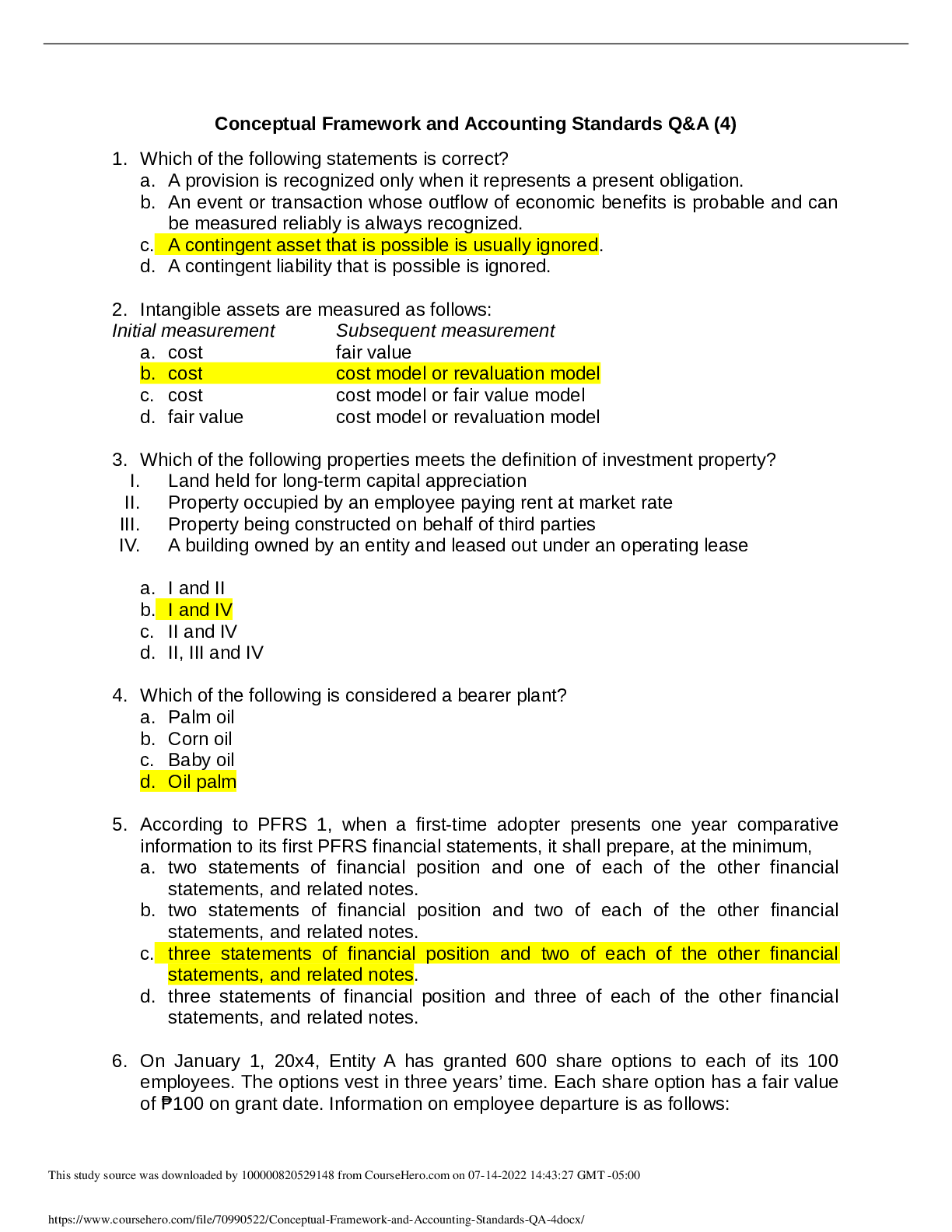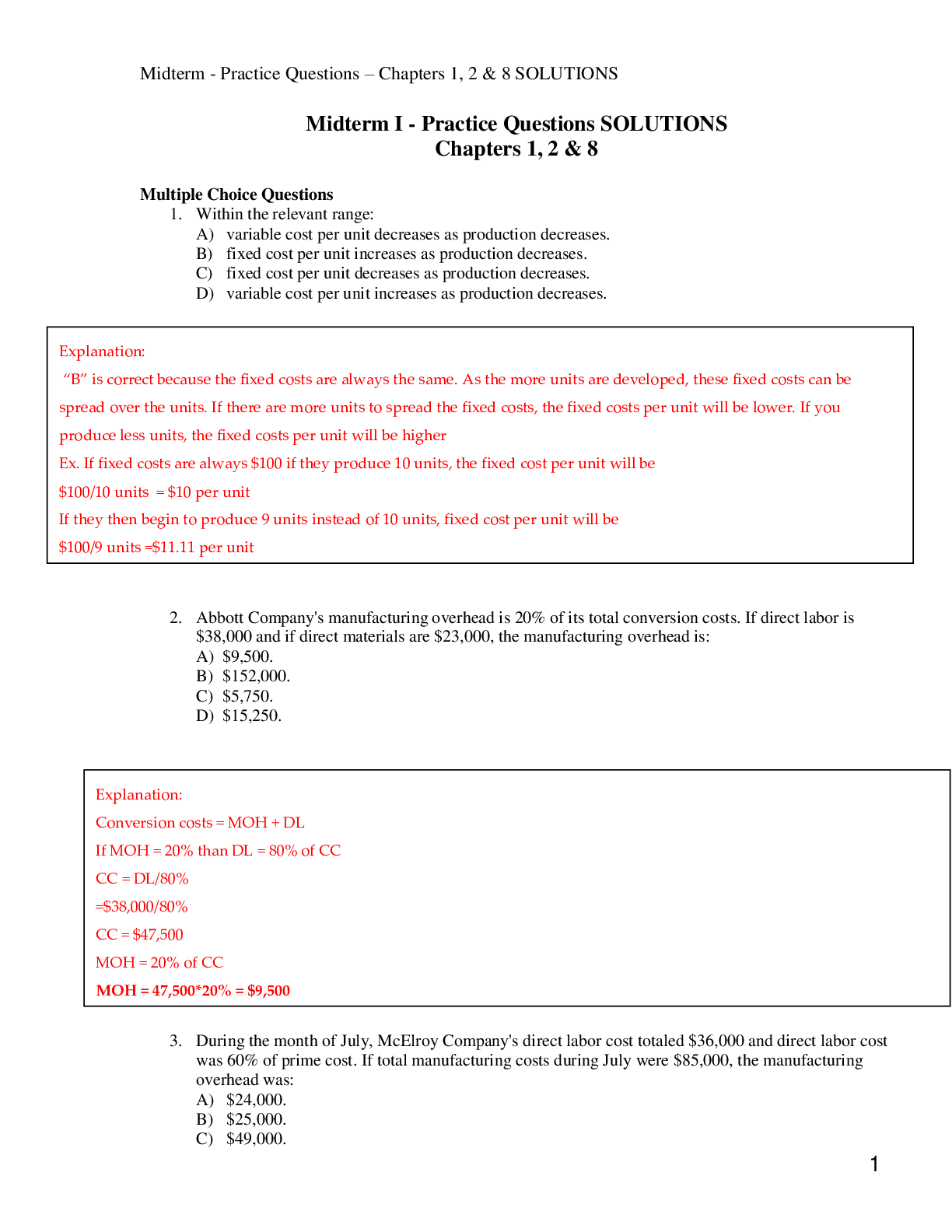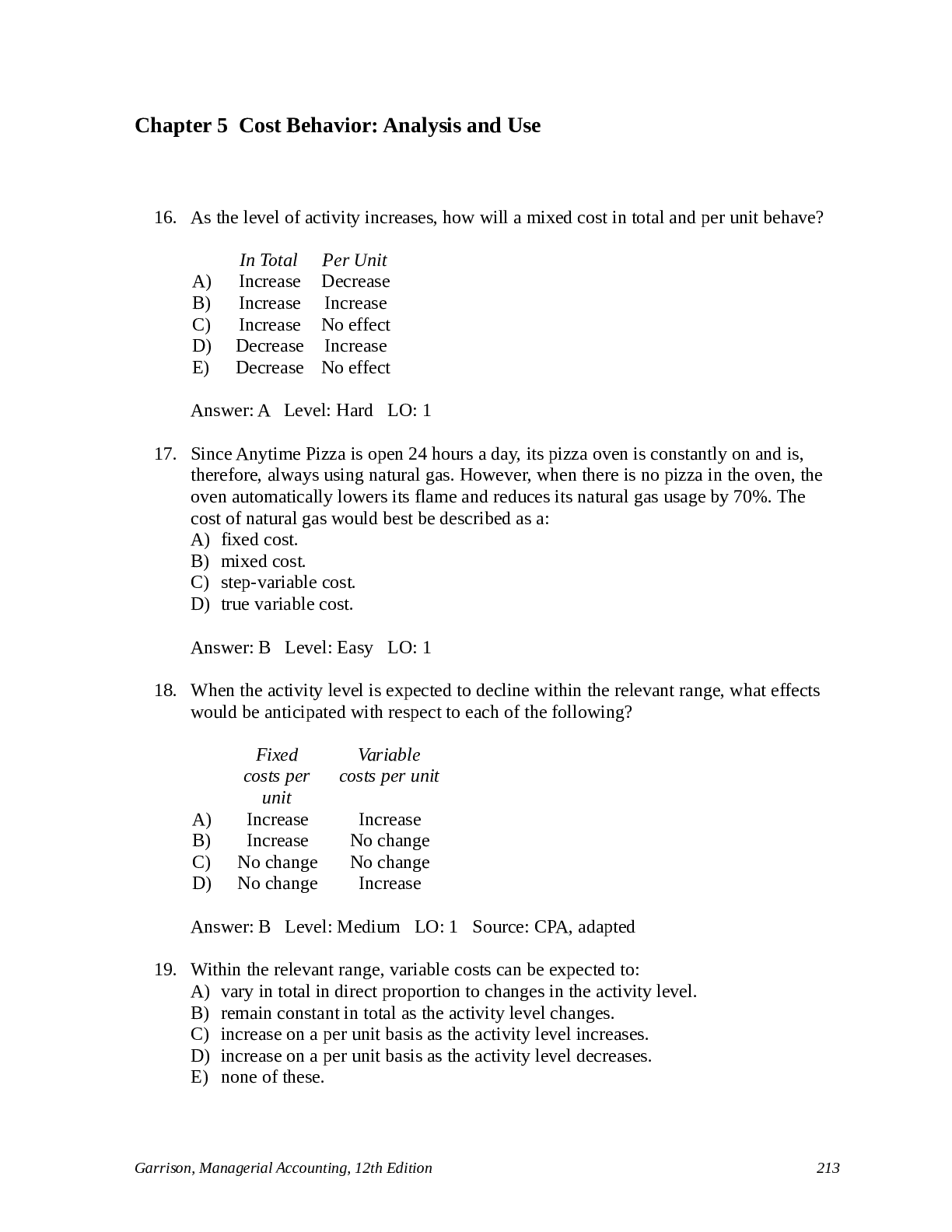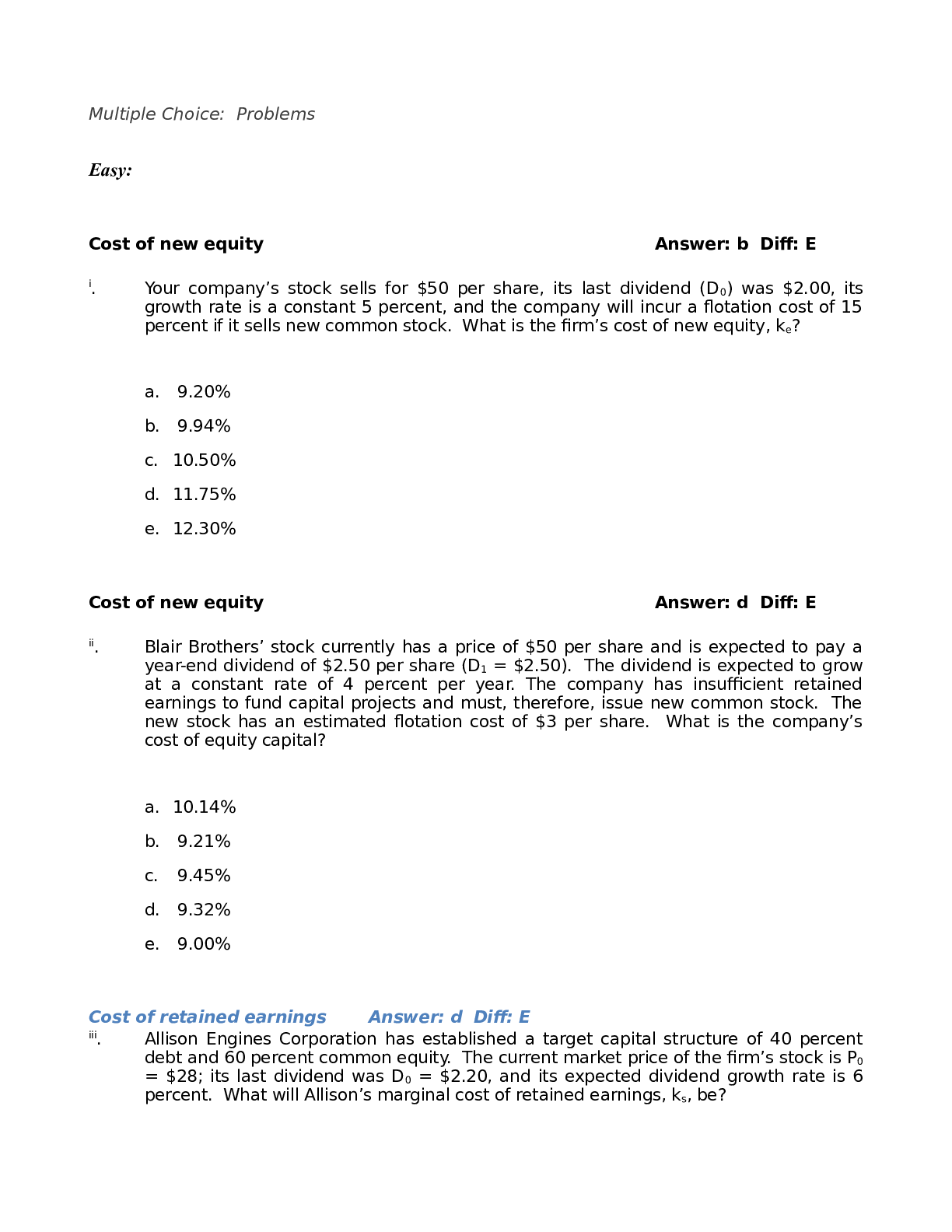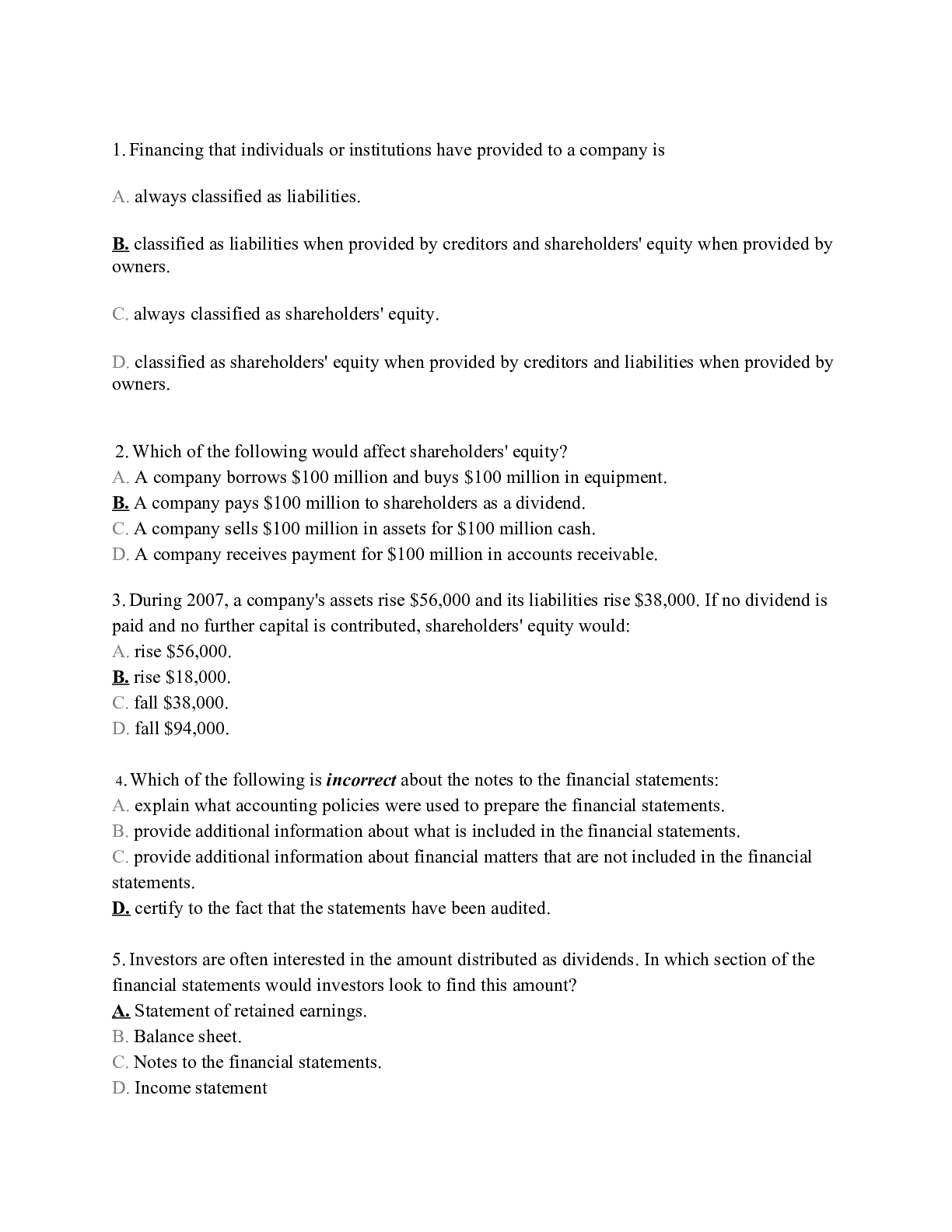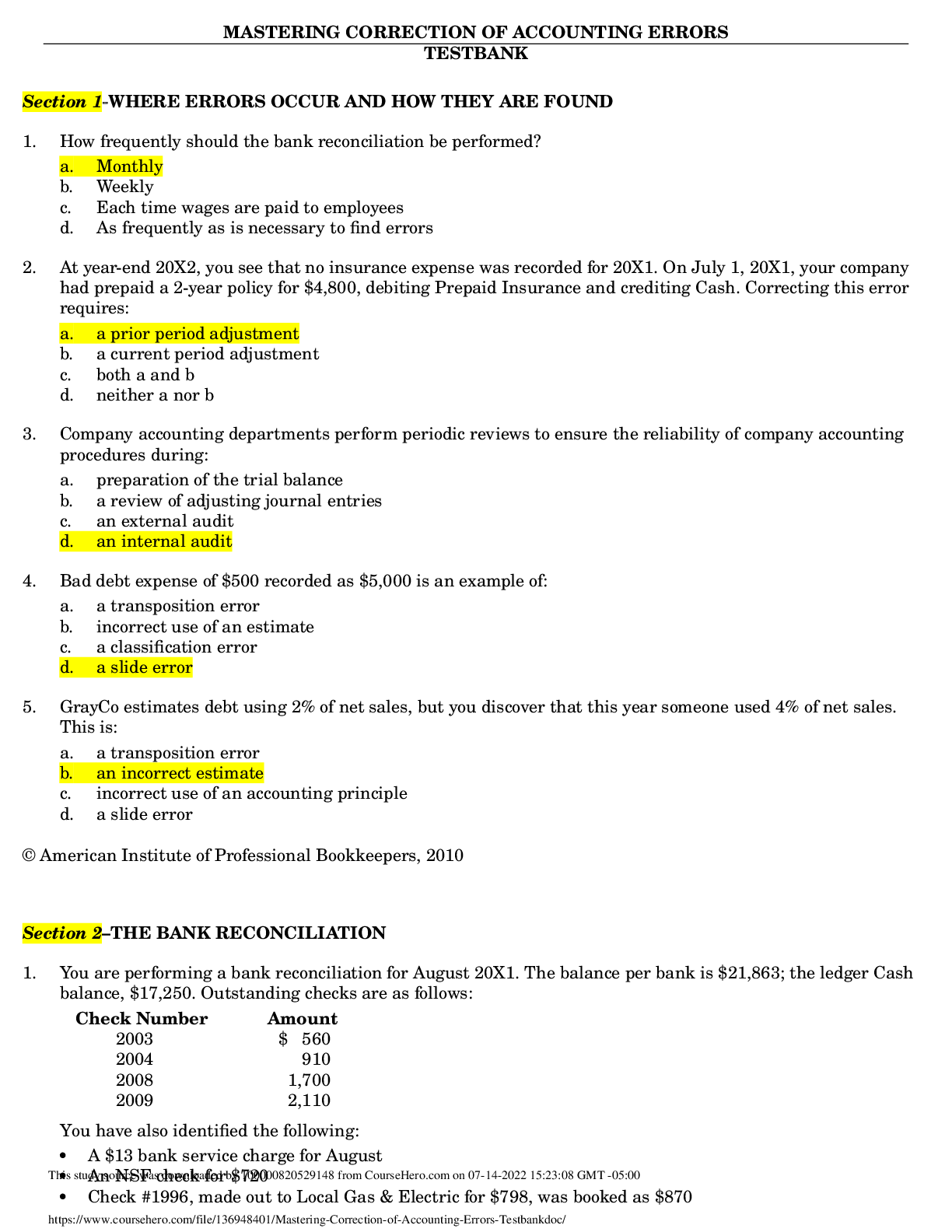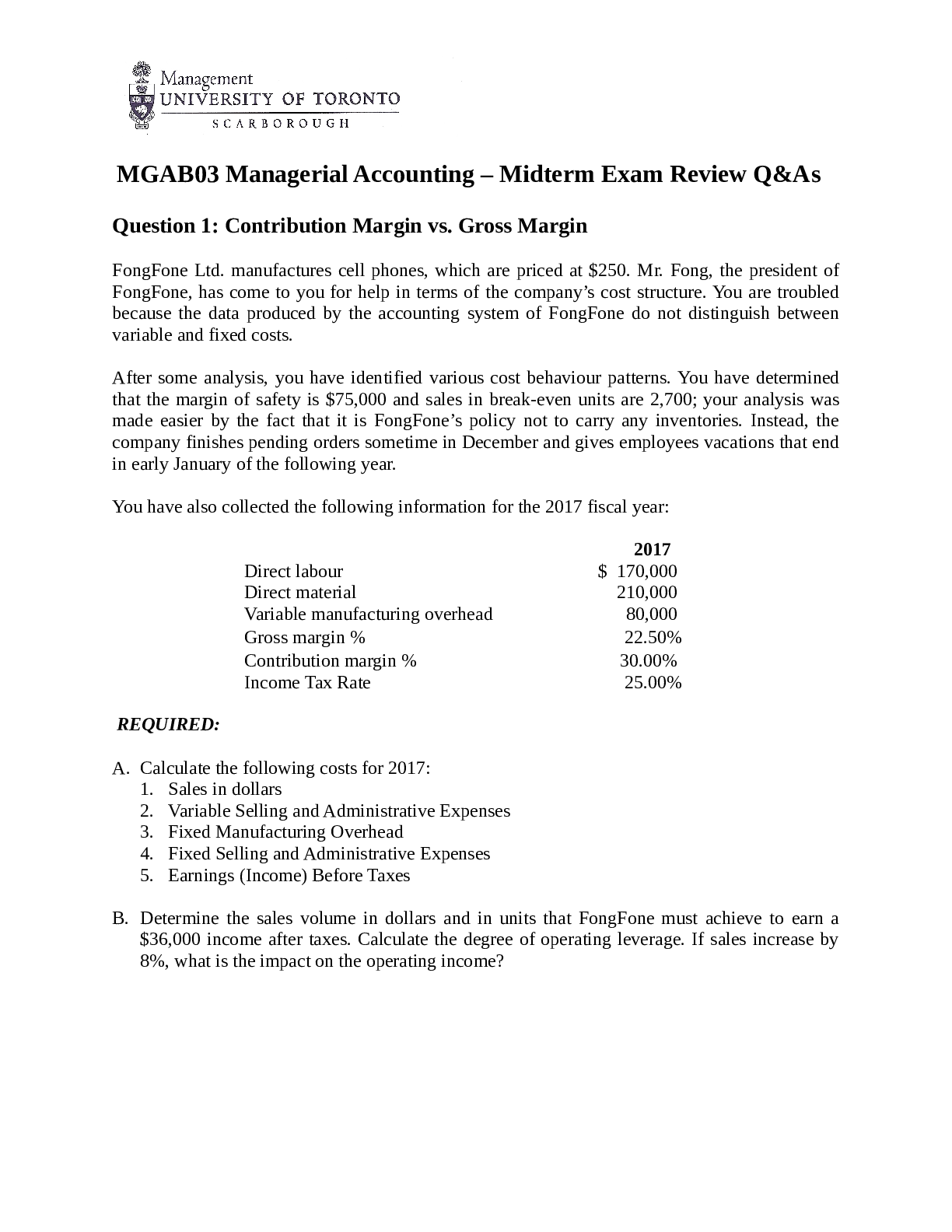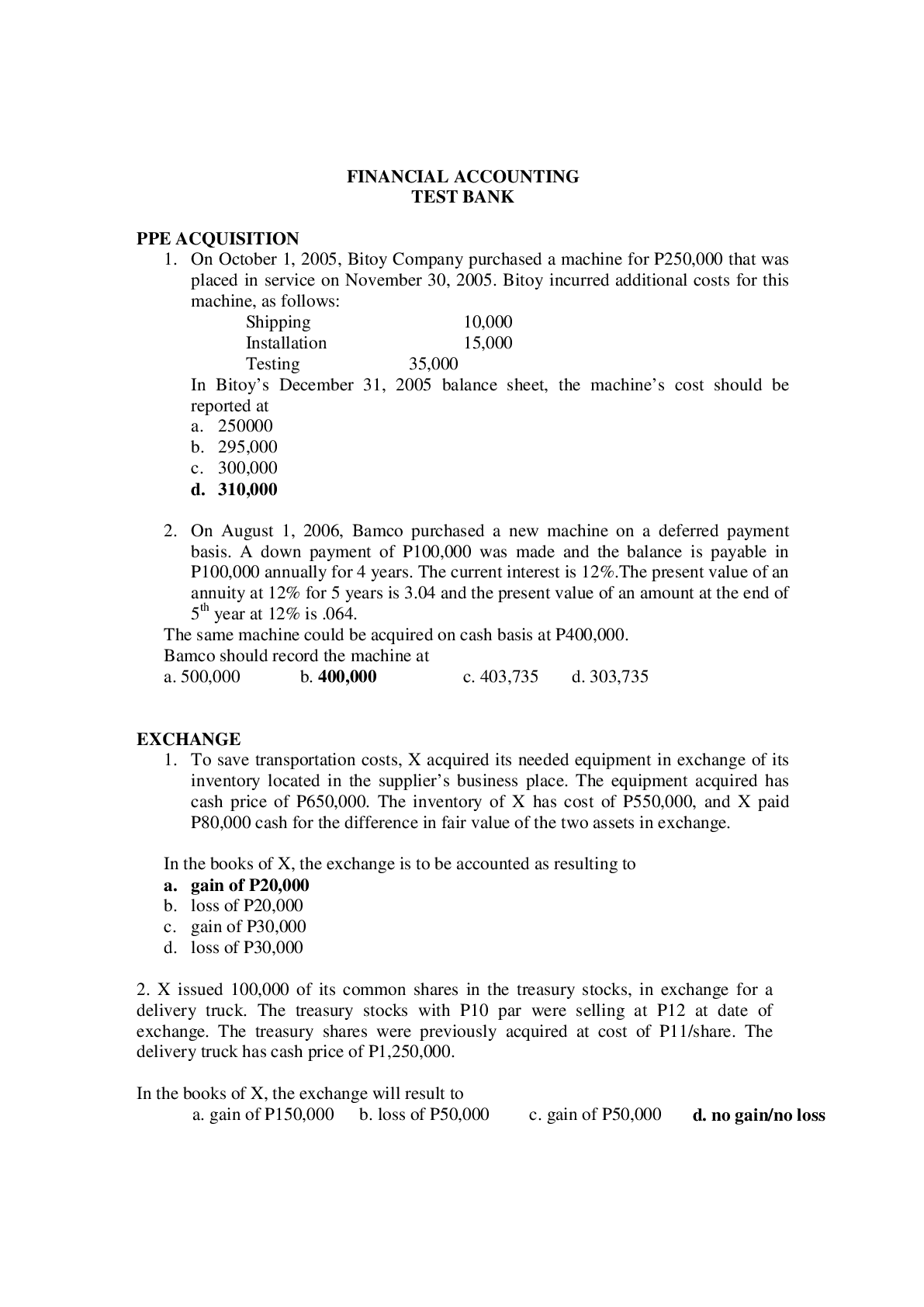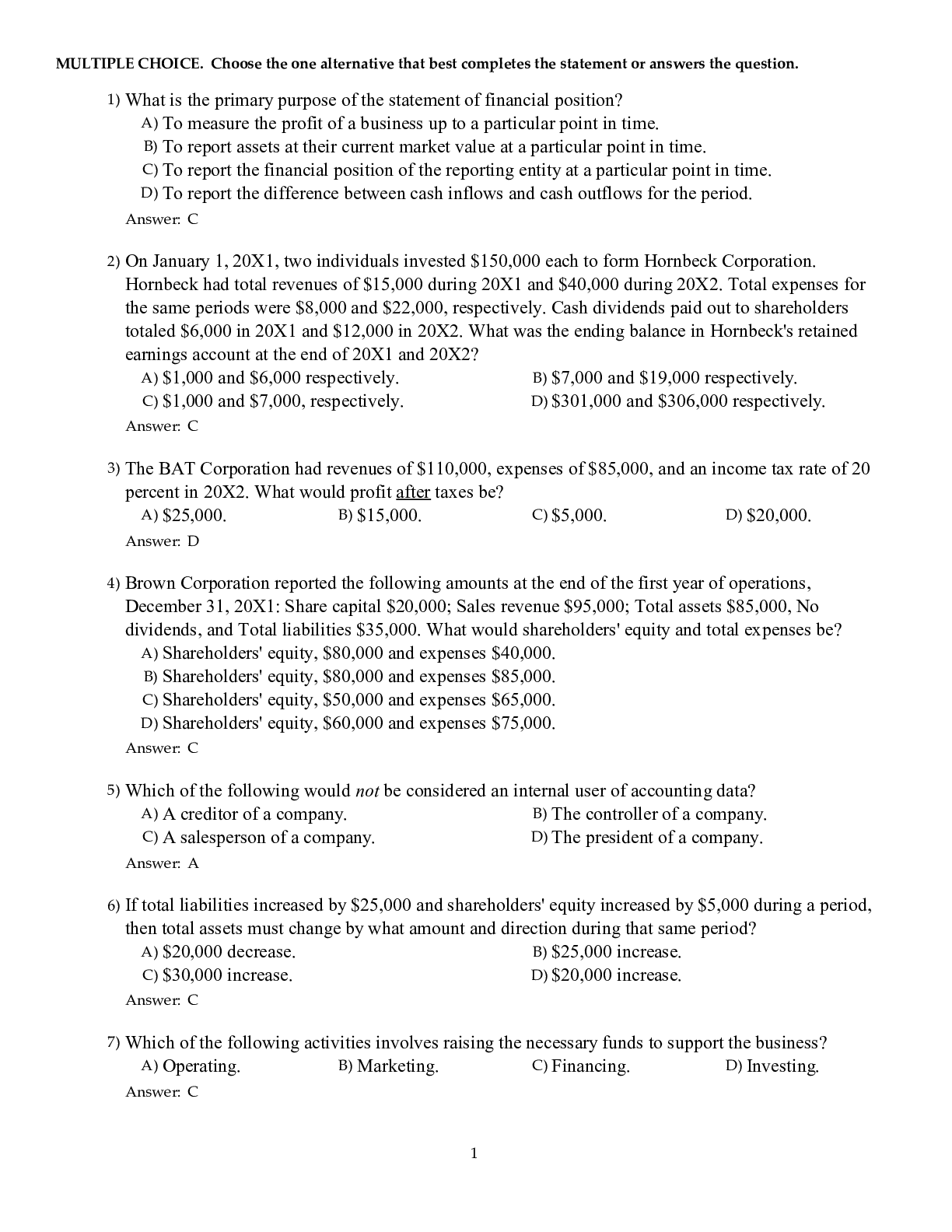Health Care > EXAM > TestBank. Brunner & Suddarth Textbook of Medical Surgical- Nursing 14th Edition (All)
TestBank. Brunner & Suddarth Textbook of Medical Surgical- Nursing 14th Edition
Document Content and Description Below
Test Bank - Brunner & Suddarth's Textbook of Medical-Surgical Nursing 14e (Hinkle 2017) 596 Hg, and the pulse is 110. The nurse documents that the patientsskin is cold, moist... , and pale. Of what is the patient showing signs? A) Hypothermia B) Hypovolemic shock C) Neurogenic shock D) Malignant hyperthermia Ans: B Feedback: The patient is exhibiting symptoms of hypovolemic shock; therefore, the nurse should notify the patients physician and anticipate orders for fluid and/or blood product replacement. Neurogenic shock does not normally result in tachycardia and malignant hyperthermia would not present at this stage in the operative experience. Hypothermia does not cause hypotension and tachycardia. 11. The PACU nurse is caring for a male patient who had a hernia repair. The patients blood pressure is now 164/92 mm Hg; he has no history of hypertension prior to surgery and his preoperative blood pressure was 112/68 mm Hg. The nurse should assess for what potential causes of hypertension following surgery? A) Dysrhythmias, blood loss, and hyperthermia B) Electrolyte imbalances and neurologic changes C) A parasympathetic reactionand low blood volumes This study source was downloaded by 100000820529148 from CourseHero.com on 10-03-2022 10:11:30 GMT -05:00 https://www.coursehero.com/file/111834738/TestBank-Brunner-Suddarth-Medical-Surgical-14th-Hinkle-2017docx-86pdf/ Test Bank - Brunner & Suddarth's Textbook of Medical-Surgical Nursing 14e (Hinkle 2017) 597 D) Pain, hypoxia, or bladder distention Ans: D Feedback: Hypertension is common in the immediate postoperative period secondary to sympathetic nervous system stimulation from pain, hypoxia, or bladder distention. Dysrhythmias, blood loss, hyperthermia, electrolyte imbalances, and neurologic changesare not common postoperative reasons for hypertension. A parasympathetic reactionand low blood volumes would cause hypotension. 12. The nurse is caring for a patient after abdominal surgery in the PACU. The patients blood pressure has increased and the patient is restless.The patients oxygen saturation is 97%. What cause for this change in status should the nurse first suspect? A) The patient is hypothermic. B) The patient is in shock. C) The patient is in pain. D) The patient is hypoxic. Ans: C Feedback: An increase in blood pressure and restlessness are symptoms of pain. The patients oxygen saturation is 97%, so hypothermia, hypoxia, and shock are not likely causes of the patientsrestlessness. This study source was downloaded by 100000820529148 from CourseHero.com on 10-03-2022 10:11:30 GMT -05:00 https://www.coursehero.com/file/111834738/TestBank-Brunner-Suddarth-Medical-Surgical-14th-Hinkle-2017docx-86pdf/ Test Bank - Brunner & Suddarth's Textbook of Medical-Surgical Nursing 14e (Hinkle 2017) 598 13. The nurse in the ED is caring for a man who has returned to the ED 4 days after receiving stitches for a knife wound on his hand. The wound is now infected, so the stitches were removed, and the wound is cleaned and packed with gauze. The ED doctor plans to have the man return tomorrow to remove the packing and resuturethe wound. You are aware that the wound will now heal by what means? A) Late intention B) Second intention C) Third intention D) Firstintention Ans: C Feedback: Third-intention healing or secondary suture is used for deep wounds that either had not been sutured early or that had the suture break down and are resutured later, which is what has happened in this case. Secondarysuture brings the two opposing granulation surfaces back together; however, this usually results in a deeper and wider scar. These wounds are also packed postoperatively with moist gauze and covered with a dry, sterile dressing. Late intention is a term that sounds plausible, but is not used in practice. Second intention is when the wound is left open and the wound is filled with granular tissue. First intention wounds are wounds made aseptically with a minimum of tissue destruction. 14. The nurse is caring for an 82-year-old female patient in the PACU. The woman begins to awaken and responds to her name, but is confused, restless,and agitated. What principle should guide the nurses subsequent assessment? This study source was downloaded by 100000820529148 from CourseHero.com on 10-03-2022 10:11:30 GMT -05:00 https://www.coursehero.com/file/111834738/TestBank-Brunner-Suddarth-Medical-Surgical-14th-Hinkle-2017docx-86pdf/ Test Bank - Brunner & Suddarth's Textbook of Medical-Surgical Nursing 14e (Hinkle 2017) 599 A) Postoperative confusion in older adults is an indication of impaired oxygenation or possibly a stroke during surgery. B) Confusion, restlessness, and agitation are expected postoperative findings in older adults and they will diminish in time. C) Postoperative confusion is common in the older adult patent, but it could also indicate a significant blood loss. D) Confusion, restlessness, and agitation indicate an underlying cognitive deficit such as dementia. Ans: C Feedback: Postoperative confusion is common in the older adult patient, but it could also indicateblood loss and the potential for hypovolemic shock; it is a critical symptom for the nurse to identify. Despite being common, it is not considered to be an expected finding. Postoperative confusion is an indication of an oxygen problem or possibly a stroke during surgery, but blood loss is more likely. A new onset of confusion, restlessness, and agitation does not necessarily suggest an underlying cognitive disorder. 15. An adult patient has just been admitted to the PACU following abdominal surgery.As the patient begins to awaken, he is uncharacteristically restless.The nurse checks his skin and it is cold, moist, and pale. The nurse concerned the patient may be at risk for what? A) Hemorrhage and shock B) Aspiration This study source was downloaded by 100000820529148 from CourseHero.com on 10-03-2022 10:11:30 GMT -05:00 https://www.coursehero.com/file/111834738/TestBank-Brunner-Suddarth-Medical-Surgical-14th-Hinkle-2017docx-86pdf/ Test Bank - Brunner & Suddarth's Textbook of Medical-Surgical Nursing 14e (Hinkle 2017) 600 C) Postoperative infection D) Hypertension and dysrhythmias Ans: A Feedback: The patient with a hemorrhage presents with hypotension; rapid, thready pulse; disorientation; restlessness; oliguria; and cold, pale skin. Aspiration would manifest in airway disturbance. Hypertension or dysrhythmias would be less likely to cause pallor and cool skin. An infection would not be present at this early postoperative stage. 16. The nursing instructor is discussing postoperative care with a group of nursing students. A student nurse asks, Why does the patient go to the PACU instead of just going straight up to the postsurgical unit? What is the nursing instructors best response? A) The PACU allows the patient to recover from anesthesia in a stimulating environment to facilitate awakening and reorientation. B) The PACU allows the patient to recover from the effects of anesthesia, and the patient stays in the PACU until he or she is oriented, has stable vital signs, and is without complications. C) Frequently, patients are placed in the medicalsurgical unit to recover, but hospitals are usually short of beds, and the PACU is an excellent place to triage patients. D) Patients remain in the PACU for a predetermined time because the surgeonwill often need to reinforce or alter the patientsincisionin the hours following surgery. Ans: B This study source was downloaded by 100000820529148 from CourseHero.com on 10-03-2022 10:11:30 GMT -05:00 https://www.coursehero.com/file/111834738/TestBank-Brunner-Suddarth-Medical-Surgical-14th-Hinkle-2017docx-86pdf/ Test Bank - Brunner & Suddarth's Textbook of Medical-Surgical Nursing 14e (Hinkle 2017) 601 Feedback: The PACU provides care for the patient while he or she recovers from the effects of anesthesia. The patient must be oriented, have stable vital signs, and show no evidence of hemorrhage or other complications. Patientswill sometimes recover in the ICU, but this is considered an extension of the PACU. The PACU does allow the patient to recover from anesthesia, but the environment is calm and quiet as patients are initially disoriented and confused as they begin to awaken and reorient. Patients are not usually placed in the medicalsurgical unit for recovery and, although hospitals are occasionally short of beds, the PACU is not used for patient triage. Incisions are very rarely modified in the immediate postoperative period. 17. The PACU nurse is caring for a patient who has arrived from the OR. During the initial assessment, the nurse observes that the patientsskin has become blue and dusky. The nurse looks, listens, and feels for breathing, and determines the patient is not breathing. What is the priority intervention? A) Check the patients oxygen saturation level, continue to monitorfor apnea, and performa focused assessment. B) Treat the possible airway obstruction by tilting the head back and pushingforwardon the angle of the lower jaw. C) Assess the arterial pulses, and place the patient in the Trendelenburg position. D) Reintubate the patient. Ans: B Feedback: This study source was downloaded by 100000820529148 from CourseHero.com on 10-03-2022 10:11:30 GMT -05:00 https://www.coursehero.com/file/111834738/TestBank-Brunner-Suddarth-Medical-Surgical-14th-Hinkle-2017docx-86pdf/ Test Bank - Brunner & Suddarth's Textbook of Medical-Surgical Nursing 14e (Hinkle 2017) 602 When a nurse finds a patient who is not breathing, the priority intervention is to open the airway and treat a possible hypopharyngealobstruction. To treat the possible airway obstruction, the nurse tilts the head back and then pushes forwardon the angle of the lower jaw or performs the jaw thrust method to open the airway. This is an emergency and requiresthe basic life support intervention of airway, breathing, and circulation assessment. Arterial pulses should be checked only after airway and breathing have been established. Reintubation and resuscitation would begin after rapidly ruling out a hypopharyngeal obstruction. 18. The nurse is providing teaching about tissue repair and wound healing to a patient who has a leg ulcer. Which of the following statements by the patient indicates that teaching has been effective? A) Ill make sure to limit my intake of protein. B) Ill make sure that the bandage is wrapped tightly. C) My foot should feel cool or cold while my legs healing. D) Ill eat plenty of fruits and vegetables. Ans: D Feedback: Optimal nutritional status is important for wound healing;the patient should eat plenty of fruits and vegetables and not reduce protein intake. To avoid impeding circulation to the area, the bandage should be secure but not tight. If the patientsfoot feels cold, circulation is impaired, which inhibits wound healing. This study source was downloaded by 100000820529148 from CourseHero.com on 10-03-2022 10:11:30 GMT -05:00 https://www.coursehero.com/file/111834738/TestBank-Brunner-Suddarth-Medical-Surgical-14th-Hinkle-2017docx-86pdf/ Powered by TCPDF (www.tcpdf.org) [Show More]
Last updated: 1 year ago
Preview 1 out of 7 pages
Instant download

Buy this document to get the full access instantly
Instant Download Access after purchase
Add to cartInstant download
Reviews( 0 )
Document information
Connected school, study & course
About the document
Uploaded On
Oct 03, 2022
Number of pages
7
Written in
Additional information
This document has been written for:
Uploaded
Oct 03, 2022
Downloads
0
Views
31

